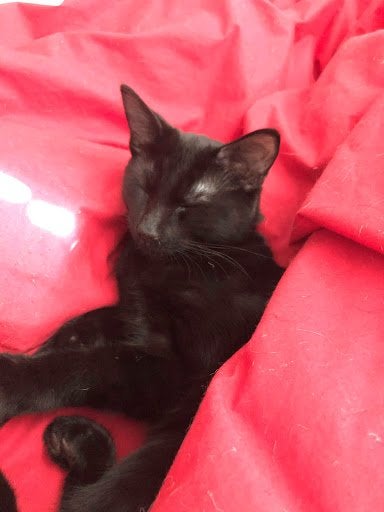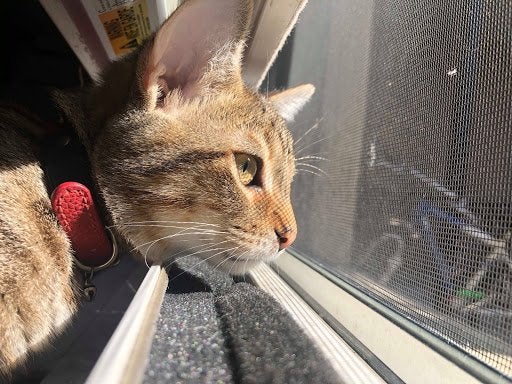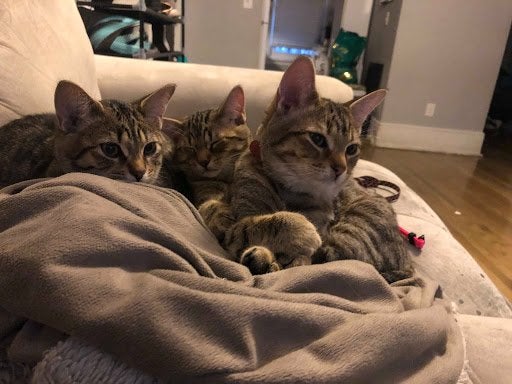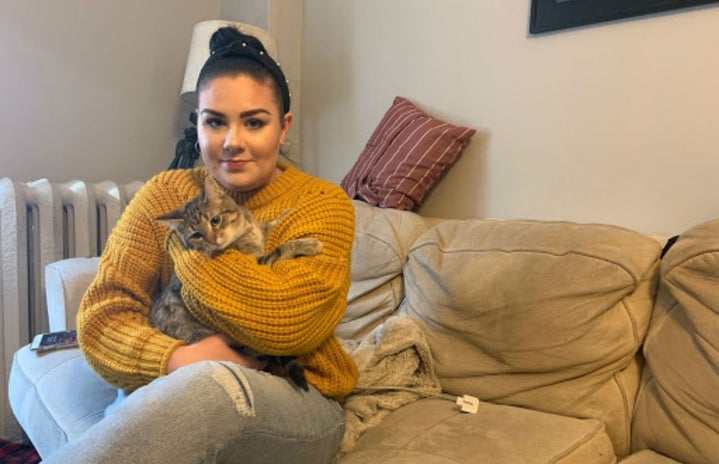When Liv Kirkwood sent her cat, Hazel, to keep her grandmother company after her grandfather’s death, she did not know she would end up with six more.
While sending her five-year-old feline friend to her grandmother’s house was well-intentioned, Liv dearly missed Hazel’s company. Living with depression and facing worsening anxiety, Liv found herself at a loss for comfort. Knowing her history with cats, Kirkwood’s psychiatrist suggested fostering cats to help soothe the void.
This led Liv to the Ottawa Stray Cat Rescue . . . and Theo, Holland, Jeta, Larson, and number of other kittens in need of a love and a litter box.

Jeta, one of the four foster cats living in Kirkwood’s apartment. Photo from Liv Kirkwood.
“I really love it,” says Kirkwood. “It’s one of the most rewarding things I’ve ever done with my life.”
Abbreviated to OSCatR, the Ottawa Stray Cat Rescue’s mission is simple: see a stray cat, save a stray cat.
Between baking goods to raise money for the organization, becoming foster parents, transporting cats to vet appointments as kitty Ubers, or crafting items to sell at shows, the OSCatR can put anyone to work in the name of Ottawa’s strays.
“If someone wanted to learn how to take care of a cat before they got one, fostering is a great way to start,” Kirkwood says.
She decided the foster parent life was for her in June 2019, and hasn’t looked back since.
With a couch no stranger to fur, a cat toy for every textbook, carriers lined against the den wall, and missing hair ties for every curious kitten, Kirkwood’s apartment transitioned from student living to the cats’ condo.
As she explains the joys and pains of raising kittens and cats who usually start off pretty hostile, a five-month-old kitten hops into her lap, rubbing his head against her wrist. This is Theo, brown and black and soft all over; too busy licking Kirkwood’s hand to notice much of anything else.
“Thank you for the kisses buddy,” she says with a smile as she rubs her fingers behind his ear.
It seems there are no complaints for Kirkwood’s hospitality. Her first foster cat, four-year-old Cassia, had been put up for adoption for two-and-a-half years. After two weeks of vigorous social media posting, Cassia was already saying goodbye to her rookie foster mom – who would soon become a natural.

Four-year-old Cassia – Kirkwood’s first foster cat. Photo from Liv Kirkwood.
Holland, a thick tabby with glowing yellow eyes, is Kirkwood’s success story. From hissing at people and refusing to socialize with the other cats, he is now one of the friendliest of the bunch because of the patience and love Kirkwood gave him.
“They need attention,” Kirkwood says. “And unless you want your kitten to turn out like a giant asshole, you need to spend time with them.”
(Kirkwood has yet to cry when giving a cat away to its new adoptive parents, but she predicts she will shed a few tears for Holland).
Though Kirkwood has many tips to offer about being a good foster parent, she says she does not believe the gig is for just anybody.
“You see some pretty messed up stuff,” she said.
From eye infections leading to lost eyes, ringworm fungus, and abused kittens failing to survive, Kirkwood makes it clear that there can be an emotional toll with fostering kittens. However, she says the good outweighs the bad.

Larson, whose red collar warns that he has ringworm. Photo from Liv Kirkwood.
“It’s hard to watch that stuff, but it’s worth it in the end because those cats are now in our care and they’re being taken care of, and we’re doing all that we can for them.”
From preliminary vet appointments, to frequent check-ups, and spoiling them with toys every once in a while, OSCatR is dedicated to treating every cat they welcome like family. However, their capacity rests on their donations and their volunteers.
Kirkwood speaks proudly of a woman who donates yearly, and most recently, gave the OSCatR $5,000. Donations like these cover vaccinations, emergency vet visits, and cat contraception.
For those who cannot give monetarily, Kirkwood encourages them to offer their homes. While OSCatR has 150 volunteers and 400 active homes across Ottawa, it still is not enough for the number of cats they find – especially after kitten breeding season at the end of the summer.

Siblings, Holland, Larson, and Theo relaxing together on Kirkwood’s couch. Photo from Liv Kirkwood.
Kirkwood says that besides occasionally buying food, there are no real financial commitments to fostering cats, since medical expenses are covered before they are put in volunteers’ care.
Because of this, Kirkwood says she could foster up to 11 cats at a time – although she would only own three at once.
Kirkwood says that in the fostering process, one is never truly alone.
“It’s a very community-based rescue,” she says. “If I have a problem, there is someone out there who is gonna be able to solve it for me.”
With the frustrations of raising abandoned cats, feeling rejected, and seeing them in harm’s way, Kirkwood is inspired when her determined nurturing brings out the affection in a cat adapting to a new home.
“Fostering really helps because I can physically see the good that I’m doing.”
With this in mind, Kirkwood encourages anyone who can offer their hands or their homes.
OSCatR is currently looking for more volunteers to help nurse their cats back to health and help them find homes. Kirkwood is not focused on numbers, so much as she is focused on how many cats they can help. Either way, she says she is in it for the long haul.
“We can’t leave the rescue. There are more cats that need our help.”



